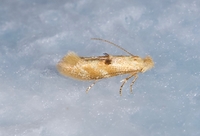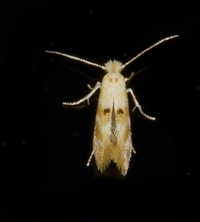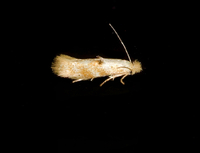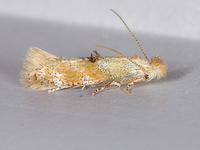Identification
Adult Markings: The following description is based on that of Braun (1963). The head is white, and the tuft white with a few yellow hairs in darker specimens. The eyecap is white, and the antennal stalk white with distinct brown annulations (pale females often have very obscure annulations). The thorax and ground color of the forewing are creamy white or pale yellow. The ground color shades to pale orange in the middle of the wing, where it forms the inner margin of an oblique costal streak of the pale yellow ground color. The streak eventually blends with the pale ground color below the fold. On the middle of the dorsum there is a patch of dark brown raised scales that varies in size, and is sometimes entirely absent. Beyond the oblique costal streak, the deeper color of the costal half of the wing borders a second pale streak which passes obliquely across the wing to the termen. In pale specimens these two oblique streaks are scarcely differentiated. In darker specimens, some of the orange scales are minutely dark-tipped. In the apical area, the scales are creamy white, with yellow and pale orange intermixed. Both the apical spot and ciliary line are missing. However, darker males have a slight deepening of color at the extreme tips of a few of the scales projecting into the cilia. The cilia is concolorous with the pale ground color. The hindwing varies from yellowish white in some females, to pale fuscous in the male. The legs are creamy white, while the abdomen has fuscous shading above. B. packardella , from which it is easily distinguished by the absence of an apical spot and ciliary line.
Wingspan: 5-6 mm (Braun, 1963)
Adult Structural Features: The male and female genitalia, along with associated scale tufts and patches, are distinctive and are described and illustrated by Braun (1963). The following are her verbatim descriptions. Males: harpes typical of the section, short and broad, with evenly rounded apex, setose, not attaining socii, which project well beyond them; socii elongate, sinus between them deep; anellus a sclerotized ring; aedeagus long, bent beyond anellus and thence attenuated to the acute apex; vinculum largely membranous, sclerotized only along its very obtusely angulated anterior margin. Scale sac small, elongate, scales long and slender (fig. 207b). Females: posterior margins of segment 7 fringed with long specialized scales dorsally and ventrally except mid-ventrally; on intersegmental membrane near posterior margin of the seventh sternite, and posterior to ostium, a pair of small specialized scale tufts; ostium with pouch-like lateral expansion; ductus bursae sclerotized in segment 7, expanded near bursa copulatrix nearly to width of bursa; signum near posterior end of bursa, signum ribs with short, basally broad, abruptly pointed, appressed spines.
Adult ID Requirements: Identifiable from good quality photos of unworn specimens.
Immatures and Development: The larval life history and ecology is poorly documented. The larvae are leafminers on oaks, but very few specifics are known about the life cycle. Braun (1963) noted that the cocoon is white and has about 8 to 10 closely placed fine ridges.

 »
»




 »
»


